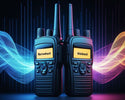
What You Need To Know About Radio Frequencies
, by Joseph Gabriel, 1 min reading time

, by Joseph Gabriel, 1 min reading time
Two-way radios are essential to communication processes in various industries. But have you ever wondered how they actually work? The answer is radio frequencies, which transmit messages between radio devices. By understanding radio frequencies, two-way radio users can better understand the devices they rely on each day. Here’s what you need to know about radio frequencies.
Radio frequencies benefit us every day. In the context of two-way radios, they allow users to communicate with each other effectively. In addition to two-way radios, these frequencies are used in computers, phones, and TVs to transmit data and communications.
Two-way radio frequencies operate within specific bands: very high frequency (VHF) and ultra high frequency (UHF). These bands each offer unique benefits and other considerations. VHF frequencies, ranging from 30 to 300 MHz, are used for long-distance communication and are often utilized by emergency services. UHF frequencies, spanning from 300 to 3,000 MHz, are commonly used in construction and similar settings due to their ability to reduce interference.
Some radios operate on UHF frequencies, while others work with VHF frequencies. Before buying any equipment, ensure your radios and accessories are compatible with your desired frequency band. There are also legal regulations surrounding the use of certain frequencies. Be sure to check your equipment and all applicable frequency regulations to ensure you are in compliance. Reputable suppliers, such as Atlantic Radio Communications Corp., can help you find reliable, compliant communication radios and accessories.
After reviewing what you need to know about radio frequencies, you can better understand which radio frequencies you should use and the proper equipment to do so. For more information on radio frequencies and two-way radio communication, feel free to reach out to our team at Atlantic Radio Communications Corp.